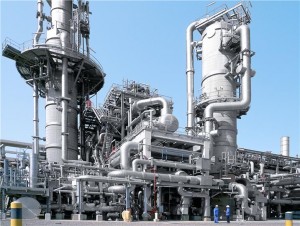The vacuum distillation process has become an important chain in maximizing the upgrading of crude oil. As distillates, vacuum gas oil (VGO), lubricating oils and/or conversion feedstocks are generally produced. The residue from vacuum distillation can be used as feedstock for further upgrading, as bitumen feedstock or as fuel component. The technology of vacuum distillation has developed considerably in recent decades, such as the vacuum unit shown in Figure 1. The main objectives have been to maximize the recovery of valuable distillates and to reduce the energy consumption of the units. For example, the direct fuel consumption of modern and efficient vacuum units is 1.0% in intake, depending on feed quality.
At the flash zone where the heated feed is introduced in the vacuum column, the temperature should be high and the pressure as low as possible to obtain maximum distillate yield. The flash temperature is restricted to about 420 °C (788 °F). In the older type high vacuum units the required low hydrocarbon partial pressure in the flash zone could not be achieved without the use of “lifting” steam. The steam acts in a similar manner as the stripping steam of crude distillation units. This type of units is called “wet” units.
One of the latest developments in vacuum distillation has been the deep vacuum flashers, in which no steam is required. These “dry” units operate at very low flash zone pressures and low pressure drops over the column internals. For that reason the conventional reflux sections with fractionation trays have been replaced by low pressure drop spray sections. The steam consumption of the dry high-vacuum units is significantly lower than that of the “wet” units. They have become net producers of steam instead of steam consumers. Three types of high-vacuum units for long residue upgrading have been developed for commercial application:
- Feed preparation units
- Luboil high- vacuum units
- High – vacuum units for bitumen production.








Leave a Reply
You must be logged in to post a comment.